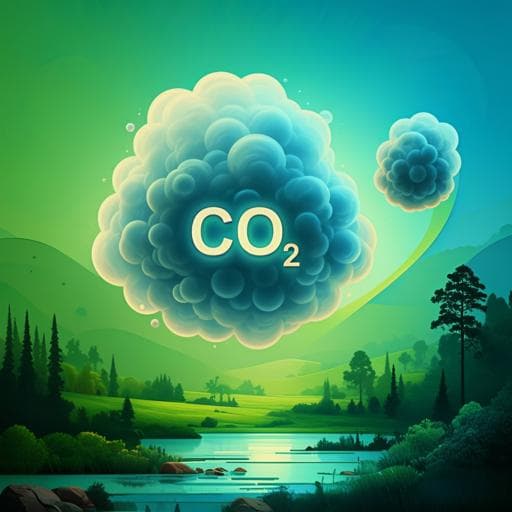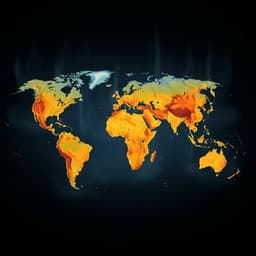
Environmental Studies and Forestry
Substantial decrease in CO2 emissions from Chinese inland waters due to global change
L. Ran, D. E. Butman, et al.
Discover how global change has dramatically influenced CO2 emissions from Chinese inland waters over the past three decades, revealing a surprising decline from the 1980s to the 2010s. This fascinating study by Lishan Ran and colleagues uncovers the interplay between dams, reforestation, and climate impacts on these crucial carbon sources.
~3 min • Beginner • English
Introduction
The study investigates how multi-decadal global change has influenced CO2 evasion from inland waters across China. Inland waters are major processors and transporters of carbon, and their CO2 outgassing is comparable in magnitude to land-atmosphere and land-ocean exchanges, yet the sensitivity of regional emissions to global change remains poorly understood. China, comprising ~7% of global land area, hosts some of the world’s largest rivers, about half of global reservoirs, and significant lake systems undergoing rapid change, but has been underrepresented in global assessments. With China’s rapid economic development, widespread dam construction, land-use change, and ecological restoration could have profoundly altered aquatic carbon dynamics. The research quantifies seasonal and annual CO2 emissions from streams/rivers, lakes, and reservoirs in the 1980s (pre-perturbation) versus the 2010s (post extensive damming and land-use change), addressing a key gap in understanding temporal responses of inland-water CO2 emissions to environmental and socioeconomic drivers.
Literature Review
Prior global estimates of inland water CO2 evasion have been refined but remain uncertain, partly due to limited inclusion of key regions such as China. Studies by Raymond et al. (2013) and Lauerwald et al. (2015) provided global patterns but relied on limited East Asian water chemistry or statistical models that may underrepresent headwaters, leading to underestimates of riverine pCO2 in China. China’s inland waters have been heavily modified by damming and land-use change; lakes have shown contrasting trends with shrinkage in the east due to reclamation and expansion in the west (including the Tibetan Plateau) due to climate-induced glacier/permafrost melt and increased precipitation. Reservoir CO2 emissions are known to be elevated initially and decline with age, often approaching lake-like behavior over time. Headwater streams globally exhibit high pCO2 and gas transfer velocities due to strong terrestrial connectivity and turbulence, making them disproportionately important for CO2 evasion. Eutrophication can shift lakes toward lower or even negative CO2 fluxes because of algal uptake. Collectively, past work suggests that both human (damming, land cover) and climate drivers (precipitation, cryosphere melt) could modulate pCO2, gas transfer, water surface area, and thus FCO2 through time, but a comprehensive, temporally explicit assessment for China has been lacking.
Methodology
Study design: Quantify and compare CO2 emissions from streams/rivers, lakes, and reservoirs across six Chinese regions (Greater Pearl, Yangtze, Huang-Huai-Hai, NE China, NW China, Tibetan Plateau) for two periods: 1980s (pre-major anthropogenic perturbations) and 2010s (post extensive damming and land-use change), with dry and wet seasons considered for streams/rivers.
Data acquisition (1980s): Compiled hydrologic gauge-based water chemistry (pH, temperature, alkalinity) at 1709 locations (1960–1985; 138,687 paired measurements; 86% from 1976–1985). Selected sites with ≥25 measurements to reduce bias; due to sparse gauges on the Tibetan Plateau, included additional data from 107 lakes to ensure spatial representation. Retained 126,713 measurements at 1508 locations for pCO2 estimation.
Data acquisition (2010s): Collected dissolved CO2 concentration and/or CO2 evasion rates from 1064 sampling locations across China. Where evasion was missing (~35% of data), calculated site-specific flux using dissolved CO2 and gas transfer velocity. Retrieved hydrological data (discharge, velocity, width, slope), climate (precipitation, temperature, wind), and land cover for analyses.
Remote sensing and GIS: Used 507 satellite images (primarily Landsat 5/7, 2005–2008) with a C# script plus visual interpretation to delineate inland waters (rivers/ditches, natural lakes, artificial reservoirs). Stream network was extracted from centerlines and manually restored using maps and high-resolution imagery; streams assigned Strahler orders. For streams, seasonal average widths were derived from 1709 gauges to compute surface areas for dry and wet seasons; network for the 1980s was reconstructed by backward updating with historical imagery, extending/deleting segments as appropriate. For lakes/reservoirs in the 1980s, due to low-resolution imagery, relied on national inventories for abundance, area, and locations; assumed small lake (<1 km2) abundance/size largely unchanged from 2010s due to their small contribution (8.3%) to total lake area; estimated small reservoir areas from inventories and 2010s average sizes, assuming similar regional distribution.
Calculation of pCO2: Assessed data quality by comparison with GEMS/Water; corrected potential overestimation in low pH/alkalinity by calibrating for biased pH and organic alkalinity following Liu et al. (2020), calibrating measurements with alkalinity <1000 μmol L−1. Calculated pCO2 from pH, temperature, alkalinity using CO2calc; validation with 329 headspace equilibrium measurements showed ~9% overestimation.
Gas transfer velocity (k): For streams/rivers, estimated k600 using two approaches: Raymond et al. (2012) hydraulic scaling (primary) and Ulseth et al. (2019) turbulence-based (comparison), distinguishing high- vs low-energy streams. k600 highest in headwaters (mean ~43 cm h−1) and decreases downstream. For lakes/reservoirs, estimated k600 from 10 m wind speed with two empirical models (Wanninkhof 2014; Cole & Caraco 1998) depending on wind speed (breakpoint 3.7 m s−1); accounted for size dependence by classifying into three surface-area classes (<10, 10–50, ≥50 km2); national average k600 ~2.2–3.6 cm h−1.
CO2 efflux computation: For sites without direct flux measurements, computed areal flux FCO2 (mmol m−2 d−1) = k × kH × ΔpCO2, where kH is Henry’s constant (temperature/pressure-corrected) and ΔpCO2 is the water-air gradient. Calculated seasonal average FCO2 (dry/wet) per region and, for streams/rivers, per Strahler order. Computed seasonal efflux by multiplying FCO2 by corresponding seasonal surface areas and ice-free days, then aggregated across orders, regions, and seasons to annual totals (Tg C yr−1) using molar mass and unit conversions. For lakes/reservoirs, computed by size class within each region and aggregated similarly.
Attribution of soil respiration contribution: Assumed soil respiration contributed 90% of degassed CO2 in headwaters and 20% in higher-order streams, lakes, and reservoirs based on literature. Derived the portion of evasion attributable to terrestrial soil respiration and the remainder from other sources (e.g., aquatic mineralization, groundwater DIC) for carbon budget implications.
Statistical and uncertainty analyses: Performed linear regressions, ANOVA, and calculated standard deviations. Propagated errors from pCO2, k, and surface area through Monte Carlo simulations (10,000 iterations), separately for streams/rivers and for lakes/reservoirs (by size classes), then combined assuming independence across water types or regions. Reported 5th–95th percentile confidence intervals. All analyses in R 3.6.0.
Key Findings
- Total CO2 evasion from Chinese inland waters decreased by ~29% over three decades: 138 ± 31 Tg C yr−1 (1980s; 5th–95th: 91–200) to 98 ± 19 Tg C yr−1 (2010s; 66–136). Streams/rivers contributed 88–93% of total.
- Streams/rivers: 128.6 ± 31.3 Tg C yr−1 (1980s) to 85.8 ± 19.4 Tg C yr−1 (2010s). Headwaters are disproportionately important, contributing 55% (1980s) and 61% (2010s) of riverine efflux while comprising 34–38% of stream surface area.
- Lakes and reservoirs: Combined evasion 9.4 Tg C yr−1 (1980s; lakes 7.3, reservoirs 2.1) increased to 12.1 Tg C yr−1 (2010s; lakes 8.4, reservoirs 3.7). Areal FCO2 for lakes/reservoirs was low (23 ± 21 mmol m−2 d−1 in 1980s; 27 ± 66 mmol m−2 d−1 in 2010s) and generally decreased with increasing waterbody size.
- Areal evasion FCO2 for streams/rivers decreased by 45%: mean annual fell from 630 to 348 mmol m−2 d−1. Seasonal FCO2 was 22–48% higher in wet vs dry season; FCO2 declined by ~13% (dry) and ~32% (wet) from 1980s to 2010s.
- Surface area changes: Stream surface area declined by 8.1–10.4% from the 1980s to 2010s (dry: 55,488 ± 12,886 to 51,003 ± 14,439 km2; wet: 65,076 ± 14,357 to 58,279 ± 15,027 km2). Lake area increased slightly (79,196 ± 6,415 to 82,570 ± 6,688 km2). Reservoir area increased by 73% (14,772 ± 1,196 to 25,616 ± 2,075 km2) with >15,000 new reservoirs and doubled storage capacity. Total inland water surface increased by ~8,600 km2 (~6%). Lentic systems (lakes + reservoirs) comprised 61–66% of inland water surface area.
- Regional contrasts: CO2 evasion increased only on the Tibetan Plateau (rivers +18%; lakes +81%), attributed to climate-driven expansion of water surfaces and increased export of terrestrial carbon. All other regions showed strong riverine declines (31–56%).
- Spatial patterns: Highest riverine FCO2 in Huang-Huai-Hai and NW China (dry climate, strong weathering, groundwater control). FCO2 decreases with Strahler order (average decline 75–123 mmol m−2 d−1 per order).
- Drivers of decline: Damming and water withdrawals reduced river surface area and turbulence (lower k), particularly in arid NW and Huang-Huai-Hai regions; reforestation decreased FCO2 (−17.4 mmol m−2 d−1 per 1% forest cover increase); cropland extent positively related to pCO2; eutrophication in eastern China reduced lake CO2 evasion, sometimes turning lakes into small sources or sinks.
- Carbon budget implications: Estimated portion of evasion from soil respiration was 77 Tg C yr−1 (1980s) and 56 Tg C yr−1 (2010s). Inland water CO2 evasion could offset China’s terrestrial carbon sink by 24–59% in the 1980s and 17–21% in the 2010s. Inland water evasion equated to ~25% of fossil fuel CO2 emissions in the 1980s and ~4% in the 2010s. The Chinese inland water efflux represents ~5–7% of global inland-water CO2 emissions, potentially increasing prior global estimates by ~0.1 Pg C yr−1.
Discussion
The study demonstrates that multi-decadal global change, particularly human modifications (damming, land-use change/reforestation, eutrophication) and climate forcing, has substantially altered CO2 emissions from China’s inland waters. The overall 29% decline in total CO2 evasion, driven by reduced riverine areal fluxes and river surface area alongside growth in low-FCO2 lentic surfaces (reservoirs/lakes), indicates that management actions that convert lotic to lentic systems and restore vegetation can significantly modulate aquatic carbon losses. In wetter eastern regions, declines in FCO2 mainly explain reduced riverine efflux, consistent with increased forest cover and eutrophication reducing dissolved CO2 availability and in-stream mineralization. In drier regions, both reduced water surface area and lower gas transfer velocities after impoundment and abstraction drive declines. In contrast, the Tibetan Plateau exhibits increasing emissions due to climate-driven hydrologic expansion and enhanced mobilization of terrestrial and ancient carbon, highlighting divergent responses under cryosphere change. Headwater dominance in riverine evasion underscores the need to resolve small streams in regional/global budgets. The findings address the central question by quantifying temporal changes and attributing drivers, and they emphasize the necessity of including inland water evasion in terrestrial carbon accounting to avoid overestimating land sinks and to better represent climate–carbon feedbacks.
Conclusion
This work provides the first comprehensive, temporally explicit assessment of CO2 evasion changes from China’s inland waters between the 1980s and 2010s. Total emissions decreased from 138 ± 31 to 98 ± 19 Tg C yr−1, primarily due to reduced riverine FCO2 and surface area associated with extensive damming, reforestation, and eutrophication, while emissions increased on the Tibetan Plateau due to climate-driven hydrologic change. Headwater streams are the dominant contributors to riverine evasion, reinforcing their critical role in carbon cycling. Incorporating inland water evasion reduces estimates of China’s terrestrial carbon sink substantially and represents a non-negligible fraction of national fossil fuel emissions and global inland-water emissions. The results highlight that integrated management of terrestrial and aquatic systems can markedly influence landscape-scale carbon fluxes. Future research should (i) integrate methane and nitrous oxide emissions, particularly from lentic and post-impoundment systems; (ii) improve direct flux measurements in under-sampled periods/regions and small waterbodies; (iii) refine attribution of sources (soil respiration vs aquatic mineralization vs groundwater DIC); and (iv) assess evolving climate impacts, especially in cryosphere-influenced regions.
Limitations
- Historical data constraints: 1980s estimates rely on calculated pCO2 from water chemistry records rather than direct evasion measurements; potential biases in low pH/alkalinity conditions were corrected but residual uncertainties remain (~9% overestimation observed).
- Remote sensing limitations: 1980s satellite imagery had low spatial resolution; lake/reservoir areas in that period were derived from national inventories and assumptions for small waterbodies (e.g., small lakes assumed largely unchanged), introducing uncertainty despite their small share of total area.
- Modeled gas transfer velocities: k600 estimates for streams/rivers and lakes/reservoirs use empirical models; uncertainties in hydraulics, wind, and turbulence propagate to FCO2.
- Reservoir treatment: Reservoirs were treated similarly to lakes, assuming elevated initial emissions decline exponentially with age; early post-impoundment pulses and methane dynamics were not explicitly quantified, potentially underrepresenting total GHG emissions.
- Attribution assumptions: The contribution of soil respiration to evasion (90% in headwaters; 20% elsewhere) is based on literature-derived assumptions and may vary regionally/seasonally.
- Seasonal/ice-free periods: Efflux calculations consider dry/wet seasons and ice-free days; uncertainties in season length and interannual variability could affect annualization.
- Spatial representativeness: Despite extensive datasets, headwater and remote regions (e.g., Tibetan Plateau) remain challenging to sample comprehensively; small ponds and ditches may be underrepresented.
Related Publications
Explore these studies to deepen your understanding of the subject.







